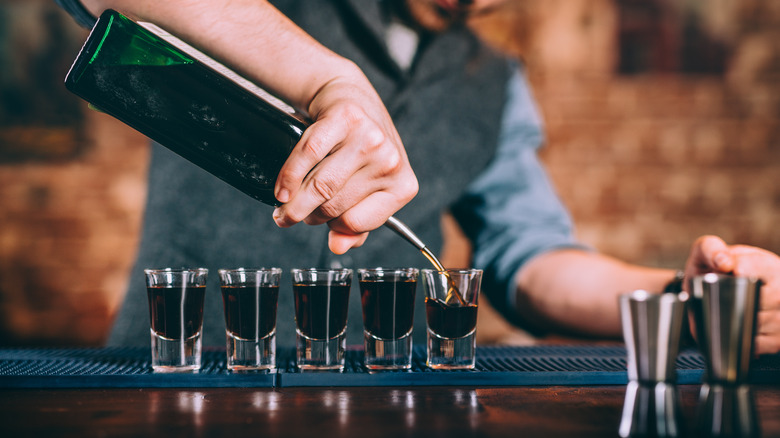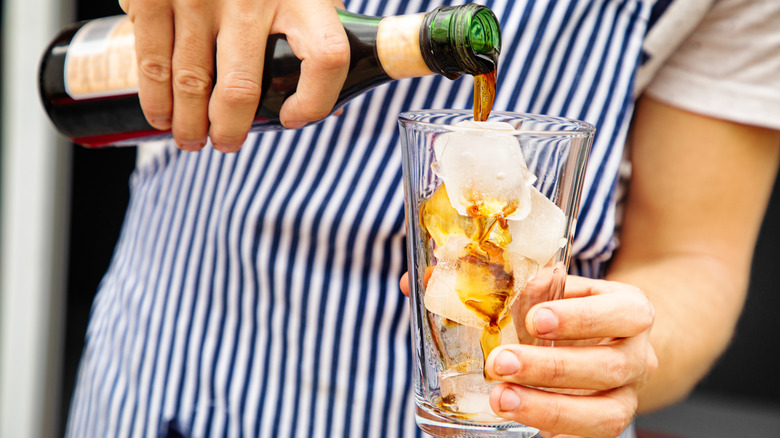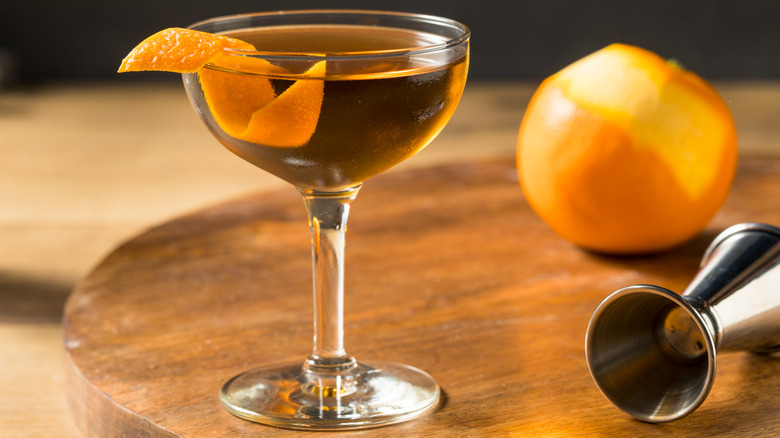Fernet Shots Are A Secret Code Between Bartenders. Here's What It Means
If you've ever taken a shot of fernet with a bartender, it's probably because you're a bartender too, or at least work in the service industry. After a long night of mixing boozy drinks — and possibly even taking shots of whiskey and tequila with guests — bartenders aren't looking to end their shifts feeling nauseated. Offering a fellow server a digestif that will settle their stomach is a sign of camaraderie, akin to a subtle nod of respect that signifies a commonality you share. For many in the industry, Fernet-Branca is the drink of choice. In fact, over the years, the liqueur has gained an almost cult-like following, with some bartenders even getting the classic eagle on the Fernet-Branca label tattooed.
At the end of the day, it's the bitterness and soothing properties of fernet that have made it so beloved. It's absolutely delicious, and for bartenders, it's almost like a secret handshake — a sign of the end of a long night. After a shot of fernet, you can go home without stomach discomfort, and a bit of pep in your step.
Don't work in the service industry? Don't worry; buying your bartender a shot of fernet can indicate that you appreciated their service, or that you're well-versed in drink culture.
What is fernet?
Fernet is a type of amaro known for its bitter, herbaceous, and pungent flavor. It first originated in Milan in 1845 and grew in popularity, eventually leading to its export overseas. It arrived in San Francisco in the late 1800s, most likely in an area of the city with a large Italian population. From San Francisco, it spread to the rest of the country. During Prohibition, fernet was sold in drug stores as medicine to help with stomach aches and fever.
This classic liqueur is typically made from ingredients like rhubarb, chamomile, and myrrh, along with intense spices such as cardamom and saffron, although the specific ingredients vary by brand. Fernet-Branca, for example, keeps its recipe secret, making it difficult to pinpoint what exactly makes its fernet the perfect digestif. However, one thing is clear: Fernet is packed with potent flavors, and is not for the faint of heart.
If you're only just beginning to learn how to drink digestifs, fernet might make you pucker. This liqueur tastes strongly of black licorice, earthy bark and roots, with a slight edge of cold medicine. If that doesn't sound appealing, don't dismiss fernet just yet. To acclimate to the pungency and bitterness of an amaro digestif, start with Aperol, then move on to something like Cynar, another bitter liqueur.
Other ways to enjoy fernet
A fernet shot can be abrasive for some, so if you're looking for other ways to enjoy the liqueur, there are plenty of cocktail options for you to try. The hanky panky is the most well-known Fernet-Branca cocktail, featuring equal parts gin and sweet vermouth, finished with a bit of Fernet-Branca and an orange peel. It's boozy and strong, but complex and incredibly herbal.
Another boozy cocktail option is the Toronto, which is a twist on the classic Manhattan. This cocktail includes rye whiskey, Fernet-Branca, Angostura bitters, and simple syrup, creating a simple yet punchy drink.
If you're not into boozy cocktails, try adding a splash of Fernet-Branca to your ginger beer or Coca-Cola. This classic mix comes from Argentina, where fernet is particularly popular. It's light and refreshing, while still featuring the bitter and pungent notes of fernet. Try this drink, and you'll grow to love fernet as a bartender does.



